ABSTRACT
We describe a new species of Pristimantis from the Comunidad Río Blanco, Cordillera del Cóndor, Ecuador. Pristimantis ledzeppelin sp. nov. is characterized by a snout–vent length of 23.9–24.6 mm in adult males (n = 2) and 36.1 mm in one adult female and is compared morphologically with Pristimantis muscosus and other similar species of Pristimantis. The new species is characterized by having skin on dorsum and flanks finely tuberculate to tuberculate, a distinctive scapular fold, skin on venter coarsely areolate; snout rounded with a small rostral papilla; discs on the digits truncate, three times the width of the digits; groin and hidden surfaces of thighs yellowish-cream with distinctive brownish-black marks and/or orange irregular blotches; and coppery red iris.
Resumen
Describimos una nueva especie de Pristimantis de la Comunidad de Río Blanco, Cordillera del Cóndor, Ecuador. Pristimantis lezeppelin sp. nov. es caracterizada por una longitud rostro-cloacal de 23.9–24.6 mm en machos adultos (n = 2), 36.1 mm en una hembra adulta, y es comparada morfológica con Pristimantis muscosus y con otras especies similares de Pristimantis. La especie nueva se caracteriza por tener la piel del dorso y flancos finamente tuberculada a tuberculada, un pliegue escapular distintivo, piel en el vientre fuertemente aerolada; hocico redondeado con una pequeña papila rostral; discos de los dígitos truncados, tres veces el ancho de los dígitos; ingles y superficies ocultas de los muslos crema amarillentas con marcas distintivas café-negruzcas o negras con manchas irregulares crema amarillentas y naranja; e iris rojo-cobrizo.
Introduction
The terrestrial frogs of the genus Pristimantis Jiménez de la Espada 1870 are an extremely diverse group of vertebrates. Currently, 569 formally described species are known [Citation1,Citation2]. Ecuador is the country with the highest richness of Pristimantis, with the latest description of 14 new species from the Ecuadorian Andes and lowlands [Citation3,Citation4]. Only in the last two years twenty-eight species of this genus have been described in Ecuador [Citation3–10], of which 14 are from the southern Andean slopes. This region has proven to be one of the most diverse in small vertebrates, with high endemism [Citation3,Citation9,Citation11–13]. The Cordillera del Cóndor is a mountain chain with a rugged topography, located in southeast Ecuador and north Peru, just east of the main body of the eastern Andes. The biodiversity of this region is still unknown, although in recent years there have been several discoveries of amphibians restricted to this endemic area [Citation14–17]. Here we describe a new species of terrestrial frog of the genus Pristimantis from the montane forest of the Comunidad Río Blanco, Cordillera del Cóndor, Ecuador.
Materials and methods
Morphological data
We follow the standardized format of Lynch & Duellman [Citation18] for description, measurements and terminology, and Duellman & Lehr [Citation19] for the definitions of diagnostic characters. We sacrificed the specimens with lidocaine, fixed them in 10% formalin and preserved them in 70% ethanol [Citation20]. We determined the sex and age by the presence of secondary sexual characteristics (nuptial pads, vocal slits, and size) and direct inspection of the gonads through a dorsolateral incision. The following measurements were taken with calipers to the nearest 0.1 mm: snout-vent length (SVL), tibia length (TL), foot length (FL), head width (HW), head length (HL), interorbital distance (IOD), width of the upper eyelid (EW), internarial distance (IND), eye-nostril distance (EN), tympanum diameter (TD), and eye diameter (ED). We recorded the life coloration pattern of the specimens with field notes and in-field color photography, the description of color patterns followed a standardized color palette [Citation21]. We determined the localities, coordinates, and elevations from field notes of the collectors and with a GPS receiver. We deposited the examined specimens at the Vertebrate Section of the Museo de Zoología, Universidad San Francisco de Quito (ZSFQ) in Quito, Ecuador. We made morphological comparisons with similar species based in specific literature as Lynch [Citation22], Duellman & Pramuk [Citation23], Yánez-Muñoz et al. [Citation24], Brito & Almendariz [Citation16]; and with specimens’ collections at ZSFQ, Instituto Nacional de Biodiversidad (INABIO) and BIOWEB online repository.
Results
Systematic accounts
Pristimantis ledzeppelin sp. nov.
Figure 1. Preserved holotype of Pristimantis ledzeppelin sp. nov., ZSFQ 1872, adult female, SVL = 36.1 mm (a) Head detail in dorsal view (b) Head detail in lateral view. Illustration by Carolina Reyes-Puig
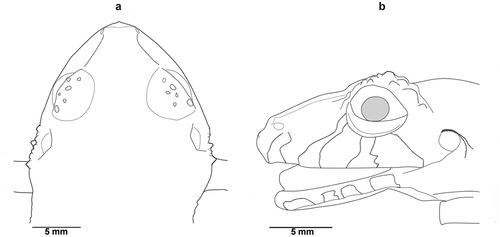
Figure 2. Map showing localities based in specimens deposited at the ZSFQ and KU collections. Triangle represents the type locality of Pristimantis ledzeppelin sp. nov.; circle represents the type locality of Pristimantis muscosus.
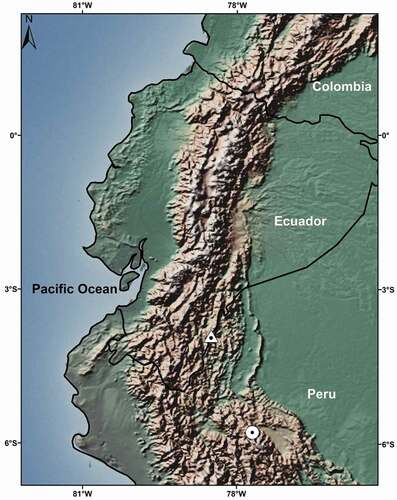
Figure 3. Palmar and plantar surfaces (a) Preserved holotype of Pristimantis ledzeppelin sp. nov., ZSFQ 1872, adult female, SVL = 36.1 mm, (b) Preserved holotype of Pristimantis muscosus, KU 219,482, adult female. Illustration (a) by Carolina Reyes-Puig, (b) modified from Duellman & Pramuk 1999 with permission
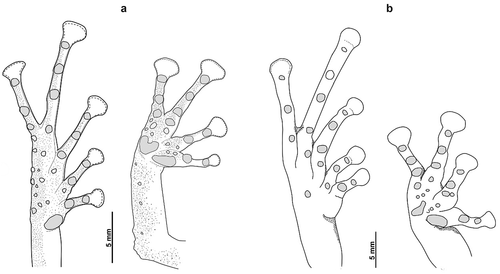
Figure 4. Preserved holotype of Pristimantis ledzeppelin sp. nov., ZSFQ 1872, adult female, SVL = 36.1 mm (a) Dorsal view (b) Ventral view (c) Lateral view. Photographs by David Brito-Zapata
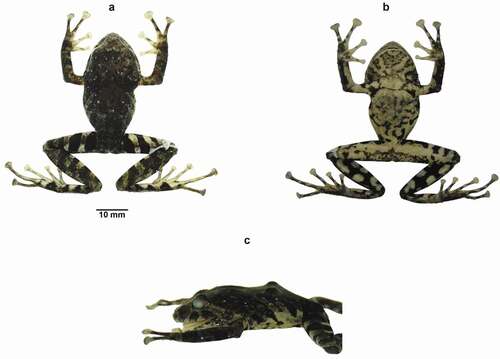
Figure 5. Coloration in life of Pristimantis ledzeppelin sp. nov. Dorsal view. (a) ZSFQ 1872, SVL = 36.1 mm, holotype, adult female; (b) ZSFQ 1878, SVL = 24.6 mm, paratype, adult male; (c) ZSFQ 1877, SVL = 23.8 mm, paratype, adult male. Ventral view (d) ZSFQ 1872, SVL = 36.1 mm, holotype, adult female; (e) ZSFQ 1878, SVL = 24.6 mm, paratype, adult male; (f) ZSFQ 1877, SVL = 23.8 mm, paratype, adult male. Photographs by David Brito-Zapata

Figure 6. Coloration in life of Pristimantis ledzeppelin sp. nov. Groin. (a) ZSFQ 1872, SVL = 36.1 mm, holotype, adult female; (b) ZSFQ 1878, SVL = 24.6 mm, paratype, adult male; (c) ZSFQ 1877, SVL = 23.8 mm, paratype, adult male. Photographs by David Brito-Zapata

Figure 7. Preserved individuals of Pristimantis ledzeppelin sp. nov. showing dorsal (a-c) and ventral (d-f) variation . (a, d) ZSFQ 1872, SVL = 36.1 mm, holotype, adult female; (b, e) ZSFQ 1878, SVL = 24.6 mm, paratype adult male; (c, f) ZSFQ 1877, SVL = 23.8 mm, paratype, adult male. Photographs by David Brito-Zapata
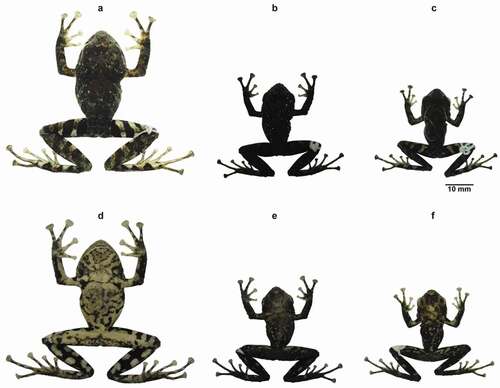
Publication LSID: urn:lsid:zoobank.org:pub:F6805531-9F5A-4C19-AD0D-570781BA4A27
Taxonomic act LSID: urn:lsid:zoobank.org:act:0E9FCE26-29CC-4634-AF71-DD13AF4B2DED
Proposed standard English name. Led Zeppelin’s Rain Frog
Proposed standard Spanish name. Cutín de Led Zeppelin
Holotype. ZSFQ 1872 (field no. DBZ 198; ), adult female, collected by David Brito-Zapata and Juan Hurtado on 20 February 2019 at Comunidad Río Blanco, Cordillera del Cóndor, Cantón Paquisha, province of Zamora Chinchipe, Ecuador (3.914297°S, 78.502472°W; 1723 m elev. ).
Paratypes (2 males). ZSFQ 1877–1878, adult males, with the same information as the holotype.
Generic placement
We assign the new species within the genus Pristimantis by having head as wide as body, tympanic membrane differentiated, cranial crests usually absent, dentigerous process of vomers present, “S” condition of the adductor muscles, terminal discs on digits expanded and bearing well-defined circumferential grooves, comparative lengths of Fingers I and II variable, Toe V as long as or longer than Toe III, texture of skin on dorsum variable, and venter areolate [Citation25].
Diagnosis
A new species of Pristimantis having the following combination of characters: (1) skin on dorsum and flanks finely tuberculate to tuberculate, with “W” shaped scapular fold (reduced by preservation effects); dorsolateral folds absent; skin on venter coarsely areolate; discoidal fold present; (2) tympanic membrane and tympanic annulus present, round, equivalent to 31.4% of ED; supratympanic fold present, extending from the eye insertion towards the posterior edge of the tympanum, covering 1/8 of the tympanum; with several conical to subconical postrictal tubercles, prominent; (3) snout rounded with a small rostral papilla in dorsal view, moderate in length and rounded in lateral view (); a row of subconical tubercles on the lower jaw; (4) upper eyelid with one evident subconical tubercle on the center of eyelid, surrounded by several lower subconical tubercles (less evident in preserved specimens) (); EW 89% of IOD; cranial crests absent; (5) dentigerous processes of vomers, prominent, triangular in outline, with three to four teeth, moderately separated, posteromedial to choanae; (6) vocal slits absent, nuptial pads present; (7) Finger I shorter that Finger II, discs of digits broadly expanded, truncate; three times the width of the digits on Fingers II to IV; (8) fingers with narrow lateral fringes; (9) ulnar tubercles present, subconical; (10) heel bearing one conical tubercle surrounded by two to five subconical low tubercles (less evident in preserved specimens), outer edge of tarsus bearing 4–6 subconical tubercles, inner tarsal fold absent; (11) inner metatarsal tubercle oval, 6X times the outer metatarsal tubercle that is subconical; supernumerary plantar tubercles present, evident, distributed throughout the plantar surface (); (12) toes with narrow lateral fringes, discs slightly less wide than those of fingers, discs of digits broadly expanded, truncate; three times the width of the digits on toes II to V, webbing basal; Toe V longer that Toe III, disc on Toe V reaches and exceeds the distal subarticular tubercle on Toe IV; (13) in life, dorsum from background beige with irregular transversal dark brown marks to greenish-brown with scattered cream dots; groin and hidden surfaces of thighs yellowish-cream with distinctive brownish-black marks (more widespread in males) and/or orange irregular blotches; venter yellowish-cream to light brown with coppery tones and marbling with dark brown; ventral surfaces of the calf brownish-black enclosing yellowish-cream to yellowish-orange blotches. Coppery-red iris with thin brown reticulations; (14) SVL in two adult males 24.3 ± 0.3 (23.9–24.6 mm); in one adult female 36.1 mm.
Comparisons with other species
Pristimantis ledzeppelin is morphologically most similar to P. muscosus [Citation23] (characters in parentheses) from the eastern slopes of the northern part of the Cordillera Central in northern Peru. However, P. ledzeppelin can be easily distinguished by having a snout rounded with a small rostral papilla (papilla absent) (); skin on venter coarsely aerolate (aerolate); discs on the digits truncate, three times the width of the digits (nearly truncate and more than twice width of the digits) (); ulnar tubercles evident, subconical (low and diffuse); supernumerary tubercles evident distributed throughout the plantar surface (prominent in a single row on each digit) (); outer edge of tarsus bearing 4–6 subconical tubercles (one or two subconical tubercles proximally); groin and hidden surfaces of thighs yellowish-cream with distinctive brownish-black marks -more widespread in males- and/or orange irregular blotches (groin and lower surfaces of hind limbs with orange-yellow spots) ().
Another species of Pristimantis morphologically similar to Pristimantis ledzeppelin is P. spinosus [Citation22] from the central south eastern slopes of Ecuador. Nevertheless, the new species can be easily distinguished by having one evident subconical tubercle on the center of eyelid, surrounded by several lower subconical tubercles (two to three elongate tubercles in P. spinosus); cranial crests absent (present, low in P. spinosus); groin and hidden surfaces of thighs yellowish-cream with distinctive brownish-black marks -more widespread in males- and/or orange irregular blotches (black enclosing white spots in P. spinosus). Other species of Pristimantis that have tones of red coloration on the iris are P. barrigai [Citation16] and P. nigrogriseus [Citation26] from de central eastern slopes of Ecuador. However, the venter of P. ledzeppelin is yellowish-cream to light brown with coppery tones and marbling with dark brown (olive to brownish-olive in P. barrigai and light brown or gray with white, cream or brown fringes in P. nigrogriseus); groin and hidden surfaces of thighs yellowish-cream with distinctive brownish-black marks -more widespread in males- and/or orange irregular blotches (olive to brownish-olive in P. barrigai and black with bright-yellow spots in P. nigrogriseus). Pristimantis cryptomelas [Citation22] from the eastern Andean slopes of southern Ecuador, the northern ridges of the Cuenca de Loja and on the western slopes of the Cordillera Huancabamba in Peru, can be similar to P. ledzeppelin by its ventral coloration. Nonetheless, the new species is characterized by having “W” shaped scapular fold (postocular and interorbial ridges present in P. cryptomelas), and skin on dorsum finely tuberculate to tuberculate (shagreen bearing conical warts and ridges in P. cryptomelas). See .
Table 1. Main characters used for morphological comparisons of the new species and similar species
Description of the holotype
Adult female. Measurements (in mm): SVL 36.1; tibia length 22.42; foot length 20.6; head length 15.6; head width 16.2; eye diameter 5.4; tympanum diameter 1.82; interorbital distance 4.71; upper eyelid width 4; internarial distance 3.5; eye–nostril distance 4.73. Head slightly wider than long (16.24 mm vs 15.63); head width 45% of SVL; head length 43.29% of SVL; snout rounded with a small rostral papilla in dorsal view, moderate in length and rounded in lateral view (); eye–nostril distance 13.1% of SVL; canthus rostralis concave in lateral view, nostrils directed laterally; interorbital area flat, wider than the upper eyelid; cranial crests absent; upper eyelid with one evident subconical tubercle on the center of eyelid, surrounded by several lower subconical tubercles (reduced by preservation effects); upper eyelid width 84.9% of IOD; tympanic membrane differentiated, tympanic annulus present, with a supratympanic fold which extends from the eye insertion to the posterior edge of the tympanum, covering 1/8 of the tympanum; tympanum diameter 45.5% of eye diameter; with four conical to subconical postrictal tubercles, prominent. Choanae moderate in size, with a round-shaped outline, not concealed by palatal shelf of maxilla; dentigerous processes of vomer prominent, triangular in outline, moderately separated, posteromedial to choanae, with three to four teeth; tongue wider than long, notched posteriorly, approximately 40% of it fixed to the mouth floor.
Skin on dorsum finely tuberculate to tuberculate, with “W” shaped scapular fold (reduced by preservation effects); dorsolateral folds absent; skin on venter coarsely areolate; discoidal fold present; cloaca with rounded warts on the outline margin. Forearms slender, ulnar tubercles present, subconical; palmar tubercle heart-shaped, bilobed, approximately one and a half the size of oval thenar tubercle; subarticular tubercles rounded, defined, prominent, supernumerary tubercles present, distinctive; fingers with narrow lateral fringes; Finger I shorter than Finger II; disc on Finger I slightly wider than the digit three times the width of the digits on Fingers II to IV, truncate; pads on fingers well defined by circumferential grooves on all fingers ().
Hindlimbs slender, tibia length 62% of SVL; foot length 57% of SVL; upper surfaces of hindlimbs shagreen; posterior surfaces of thighs smooth, ventral surfaces coarsely areolate heel bearing one conical tubercle surrounded by three subconical low tubercles (less evident by preservation effect); inner tarsal fold absent; inner oval, 6× times the outer metatarsal tubercle that is subconical; supernumerary plantar tubercles present, evident, distributed throughout the plantar surface; toes with narrow lateral fringes; webbing basal; discs of digits broadly expanded, truncate; three times the width of the digits on toes II to V; all toes with ventral pads well defined by circumferential grooves; disc on Toe V reaches and exceeds the distal subarticular tubercle on Toe IV ().
Color of holotype in life (based on digital photographs) ()
Dorsum background beige with irregular transverse dark brown marks, with scattered cream dots; dorsal surface of hindlimbs with transversal brownish-black bars; flanks beige with diagonal dark brown stripes; head with subocular and labials diagonal brown bars. Venter yellowish-cream with coppery tones, marbled with dark brown; throat yellowish-cream with “V”-shaped brown mark and two lateral diagonal brown bars; ventral surfaces of the calf brownish-black enclosing yellowish-cream blotches; groin and hidden surfaces of the thigh yellowish-cream with distinctive brownish-black marks. Coppery-red iris with thin brown reticulations.
Color of holotype in ethanol 70% ()
Dorsum light brown to gray with irregular dark brown marks, dorsal surface of the snout gray; dorsal surface of hindlimbs with transversal black and white bars; with subocular and labials diagonal brown bars; flanks light brown with diagonal dark brown stripes; groin and hidden surfaces of the hindlimbs white with black marks. Venter and throat white marbled with dark brown, throat with “V”-shaped light brown mark and two lateral diagonal light brown bars; ventral surfaces of the calf black enclosing white blotches. Coppery iris.
Variation. Preserved individuals ()
In the type series, adult males (23.9–24.6 mm) are smaller than one female (36.1 mm). See for measurements of the type specimens. Males have cream nuptial pads located in the lower external portion of the Finger I. The “W”-shaped scapular fold is present in all individuals but is less evident on the female (ZSFQ 1872) (). One male (ZSFQ 1878) shows more prominent and evident tubercles (). Background coloration varies from light brown to gray with irregular dark brown marks (ZSFQ 1872) to grayish-brown (ZSFQ 1877) to black (1878). Groin and hidden surfaces of thighs white with black marks, these marks are more widespread on the males (ZSFQ 1877–1878) . Venter from white (ZSFQ 1872), cream (1877), and light brown (1878) marbling with dark brown. All specimens present a “V” shaped brown mark on the throat () and coppery iris.
Table 2. Measurements (in mm) of type series of Pristimantis ledzeppelin sp. nov. Ranges followed by mean and standard deviation in parentheses
Coloration in life (based on digital photographs of the type specimens) ()
Dorsum background beige with irregular transversal dark brown marks (ZSFQ 1872) to greenish-brown (ZSFQ 1877–1878), with scattered cream dots; one male (ZSFQ 1877) shows irregular brownish-cream lines (); groin and hidden surfaces of thighs yellowish-cream with distinctive brownish-black marks (more widespread in males ) and/or orange irregular blotches (); venter yellowish-cream (ZSFQ 1872) to light brown (1877–1878) with coppery tones and marbling with dark brown; ventral surfaces of the calf brownish-black enclosing yellowish-cream (ZSFQ 1872) to yellowish-orange (ZSFQ1877–1878) blotches. Coppery-red iris with thin brown reticulations ().
Distribution and natural history
Pristimantis ledzeppelin is only known from the type locality of Comunidad Río Blanco, Cordillera del Cóndor, Cantón Paquisha, province of Zamora Chinchipe, Ecuador (). This locality is comprised of low montane cloud forest with a canopy 15 m to 20 m high; trees are covered by moss and there is much leaf litter on the ground [Citation27]. The elevation of the type series is 1723 m above sea level.
All specimens were found on shrub vegetation surrounding streams inside mature forest, where they perched on bush leaves, between 170 and 300 cm above the water body. The specimens were collected with other species of amphibians such as Chimerella mariaelenae, Pristimantis quaquaversus, P. prolatus and P. galdi. Stomach contents from specimen ZSFQ 1878 were identified as remnants of insects from families Curculionidae and Formicidae, and from the order Dermaptera and class Gastropoda.
Etymology
The name honours Led Zeppelin and their extraordinary music. Led Zeppelin was a British rock band formed in London in 1968, one of the most influential bands throughout the 1970s, and progenitors of both hard rock and heavy metal [Citation28].
Discussion
The Cordillera del Cóndor is an important area of the Andes between south eastern Ecuador and north eastern Peru. Due to its geographical position, topography and environmental characteristics, this emblematic mountain range encompasses an extremely particular flora and fauna with high endemism [Citation29–31]. Terrestrial frogs of the genus Pristimantis are one of the vertebrate taxa with the highest diversity and endemism in this area. In the last decade, five species of Pristimantis have been formally described: Pristimantis minimus [Citation32], P. paquishae [Citation14], P. muranunka [Citation33], P. yantzaza [Citation17], and P. barrigai [Citation16], all of them endemic to Cordillera del Cóndor and only known from their type localities and nearby areas.
The most similar species to Pristimantis ledzeppelin is P. muscosus [Citation23], however, the evidence we present confirms the morphological difference from topotypical populations. Pristimantis ledzeppelin can be easily distinguished by having a small rostral papilla, discs three times the width of the digits, and yellowish-cream or black groin and hidden surfaces of thighs with distinctive brownish-black marks or orange irregular blotches. The original description for P. muscosus illustrates a rostral papilla absent, digits nearly truncate and more than twice width of the digits, and groin and lower surfaces of hindlimbs with orange-yellow spots [Citation23]. Considering the previous features, we suggest that reports made by Almendariz et al. [Citation34] and Yánez-Muñoz et al. [Citation24], require an exhaustive morphological review, mainly because the ventral and groin coloration pattern does not match the original description of P. muscosus [Citation23]. The specimens reported by Yánez-Muñoz et al. [Citation24] from Reserva Tapichalaca clearly exhibit a black groin coloration with well-defined white spots (for more life photographs see Ron et al. [Citation35]). On the other hand, the report of Almendariz et al. [Citation34] needs verification since it only shows a dorsolateral photo; the outer edge of tarsus of the recorded specimen presents four conical tubercles, while topotypical P. muscosus are characterized by bearing one or two subconical tubercles proximally.
Further examination of this material is needed not just due to morphological variation but also due to the geographic distance between topotypical populations of Pristimantis muscosus and those reported by Yánez-Muñoz et al. [Citation24] and Almedáriz et al. [Citation34] The specimen reported by Almedáriz seems to be more similar with P. ledzeppelin than with P. mucosus and also its recorded relatively near the topotypical locality of the new species.
The Cordillera del Cóndor is part of one of the most threatened ecoregions in the world [Citation36], since it is part of tropical Andes. The main conservation threats that this area faces, according to Guayasamín and Bonaccorso [Citation31] are: a) expansion of the agricultural and livestock borders, b) logging, c) small and large-scale mining, d) introduction of disease and e) the possible effects of climate change. Particularly in the type locality of Pristimantis ledzeppelin sp. nov. livestock activities, timber extraction, small-scale mining can be observed, and large-scale mining is likely to become active because the area is within a mining concession of a multinational company [Citation37]. Due to the high endemism of the Cordillera del Cóndor, the new species here described is likely to be found only in this restricted area, therefore it is important to consider new long-term initiatives for small vertebrate conservation actions.
Author contributions
CRP and DBZ performed the experiments, contributed reagents/materials/analysis tools, authored or reviewed drafts of the paper, approved the final draft.
Disclosure of potential conflicts of interest
No potential conflict of interest was reported by the author(s).
Acknowledgments
We are extremely grateful to Lou Jost for his accurate review comments and for the English review throughout the manuscript. We thank to Juan Hurtado for his field assistance and Mariela Domínguez for the identification of stomach content of specimen ZSFQ-1877. Ministerio del Ambiente issued collection permits No. 005-2019-IC-FLO-FAU-DPAZCH-UPN-VS/MA. We also thank Mario Yánez-Muñoz (INABIO) for accessing the collections under his charge during the years 2015-2016. Work by CRP is supported by COCIBA grants (HUBI ID: 48, 12268), USFQ.
Additional information
Funding
References
- Jiménez de la Espada M. Fauna neotropicalis species quaedam nondum cognitae. 1870;3:57–65. Jornal De Sciências, Mathemáticas, Physicas E Naturaes.
- Frost DR. Amphibian Species of the World: an Online Reference. Version 6.0 New York, USA:American Museum of Natural History. 2020. cited 2020 Jan 21. Available from: http://research.amnh.org/vz/herpetology/amphibia/
- Paez NB, Ron SR. Systematics of Huicundomantis, a new subgenus of Pristimantis (Anura, Strabomantidae) with extraordinary cryptic diversity and eleven new species. Zookeys. 2019;868:1–112.
- Reyes-Puig C, Yánez-Muñoz MH, Ortega JA, et al. Relaciones filogenéticas del subgénero Hypodictyon (Anura: Strabomantidae: pristimantis) con la descripción de tres especies nuevas de la región del Chocó. Rev Mex Biodivers. 2020;91:1–38.
- Reyes-Puig C, Pablo Reyes-Puig J, Velarde-Garcez D, et al. A new species of terrestrial frog Pristimantis (Strabomantidae) from the upper basin of the Pastaza River, Ecuador. Zookeys. 2019;832:113–133.
- Yánez-Muñoz MH, Veintimilla-Yanez D, Batallas D, et al. A new giant Pristimantis (Anura, Craugastoridae) from the paramos of the Podocarpus National Park, southern Ecuador. Zookeys. 2019;852:137–156.
- Urgilés VL, Székely P, Székely D et al., 2017 and description of two new terrestrial frogs from the Pristimantis orestes species group (Anura, Strabomantidae). ZooKeys. 2019;864:111–146.
- Jh V, Valladares-Suntasig F, Tipantiza-Tuguminago L, et al. A new species of terrestrial-breeding frog of the genus Pristimantis (Anura: Terrarana: Craugastoridae) from the eastern Andean slopes of the southern Ecuador. Zootaxa. 2019 Aug 23;4658(3):zootaxa4658 3 4.
- Ramírez Jaramillo S, Reyes-Puig CP, Batallas D, et al. Ranas terrestres en los ecosistemas surandinos de Ecuador IV: una nueva especie de Pristimantis (Anura: Strabomantidae) de los páramos sur del Parque Nacional Sangay. Avances en Ciencias e Ingenierías. 2018;10(16):1–17.
- Ron SR, Carrión J, Caminer MA, et al. Three new species of frogs of the genus Pristimantis (Anura, Strabomantidae) with a redefinition of the P. lacrimosus species group. ZooKeys. 2020;993:121–155.
- Betancourt R, Reyes-Puig C, Lobos SE, et al. Sistemática de los saurios Anadia Gray, 1845 (Squamata: Gymnophthalmidae) de Ecuador: límite de especies, distribución geográfica y descripción de una especie nueva. Neotrop Biodivers. 2018;4(1):83–102.
- Sornoza-Molina F, Freile JF, Nilsson J, et al. A striking, critically endangered, new species of hillstar (Trochilidae: Oreotrochilus) from the southwestern Andes of Ecuador. Auk. 2018;135(4):1146–1171. .
- Fernández de Córdova J, Nivelo-Villavicencio C, Reyes-Puig C, et al. A new species of crab-eating rat of the genus Ichthyomys, from Ecuador (Rodentia, Cricetidae, Sigmodontinae). Mammalia. 2019;84(4):377–391.
- Brito MJ, Batallas RD, Velalcázar D. Nueva especie de rana terrestre del género Pristimantis (Amphibia: Craugastoridae), meseta de la Dordillera del Cóndor. Papéis Avulsos De Zoologia (São Paulo). 2014;54(30):435–466.
- Brito J, Batallas D, Yánez-Muñoz MH. Ranas terrestres Pristimantis (Anura: Craugastoridae) de los bosques montanos del río Upano, Ecuador: lista anotada, patrones de diversidad y descripción de cuatro especies nuevas. Neotrop Biodivers. 2017;3(1):125–156.
- Brito J, Almendariz A. Una especie nueva de rana Pristimantis (Amphibia: Strabomantidae) de ojos rojos de la Cordillera de Cóndor, Ecuador. Cuadernos de Herpetología. 2018;32(1):1.
- Valencia JH, Dueñas MR, Szèkely P, et al. A new species of direct-developing frog of the genus Pristimantis (Anura: Terrarana: Craugastoridae) from Cordillera del Cóndor, Ecuador, with comments on threats to the anuran fauna of the region. Zootaxa.2017 Nov 24;4353(3):447–466.
- Lynch JD, Duellman WE. Frogs of the genus Eleutherodactylus (Leptodactylidae) in western Ecuador: Systematic, ecology, and biogeography. Vol. 23. Vol. 1. University of Kansas Natural History Museum of Kansas; 1997. Lawrence, Kansas.
- Duellman WE, Lehr E. Terrestrial-breeding frogs (Strabomantidae) in Peru. Münster, Germany: Nature und Tier Verlag; 2009.
- Lips KR, Reaser JK, Young BE Amphibian monitoring in Latin America: a protocol manual. Vol. 115. 2001. ( SSAR, Shoreview, MN; 7).
- Connecticut Uo. Brand Standards, Color Palette: University of Connecticut 2021. Available from: https://brand.uconn.edu/guidelines-usage/color-palette/#
- Lynch JD. Leptodactylid frogs of the genus Eleutherodactylus from the Andes of southern Ecuador. Museum of Natural History, Lawrence: University of Kansas Publications; 1979.
- Duellman WE, Pramuk JB. Frogs of the genus Eleutherodactylus (Anura: leptodactylidae) in the Andes of northern Peru. 1999;13:1–78. Scientific Papers Natural History Museum the University of Kansas.
- Yánez-Muñoz MH, Toral-Contreras E, Meza-Ramos P, et al. New country records for five species of Pristimantis Jiménez de la Espada, 1870 from Ecuador. Check List. 2012;8(2):286–290.
- Hedges SB, Duellman WE, Heinicke MP. New World direct-developing frogs (Anura: terrarana): molecular phylogeny, classification, biogeography, and conservation. Zootaxa. 2008;1737(1):1.
- Andersson LG. Batrachians from East Ecuador, collected 1937, 1938 by Wm. Clarke-Macintyre and Rolf Blomberg. 1945;37(2):1–88. Arkiv För Zoologi.
- MAE. Sistema de clasificación de los ecosistemas del Ecuador continental. Quito: subsecretaría de Patrimonio Natural; 2012.
- S. F. Led Zeppelin | British rock group 2019 [cited 2019 Mar 24]. Available from: https://www.britannica.com/topic/Led-Zeppelin
- Neill DA. Cordillera del Cóndor: botanical treasures between the Andes and the Amazon. 2005;41:17–21. Plant Talk.
- Clark JL, Neill DA, Weber A, et al. Shuaria (Gesneriaceae), an Arborescent New Genus from the Cordillera del Cóndor and Amazonian Ecuador. Systemat Bot. 2010;35(3):662–674.
- Guayasamin JM, Bonaccorso E Evaluación Ecológica Rápida de la Biodiversidad de los Tepuyes de la Cuenca Alta del Río Nangaritza, Cordillera del Cóndor, Ecuador. Quito, Ecuador: Conservación Internacional; 2011.
- Terán-Valdez A, Guayasamin JM. The smallest terrestrial vertebrate of Ecuador: a new frog of the genus Pristimantis (Amphibia: strabomantidae) from the Cordillera del Cóndor. Zootaxa. 2009;2447:1.
- Brito J, Almendariz CA, Batallas RD, et al. Nueva especie de rana bromelícola del género Pristimantis (Amphibia: craugastoridae), meseta de la Cordillera del Cóndor, Ecuador. 2017;57:15. Papéis Avulsos De Zoologia (São Paulo).
- Almendariz A, Simmons JE, Brito J, et al. Overview of the herpetofauna of the unexplored Cordillera del Condor of Ecuador. 2014;8:45–64. Amphibian & Reptile Conservation.
- Ron S, Merino-Viteri A, Ortiz. Anfibios del Ecuador. Version 2019.0. Museo de Zoología, Pontificia Universidad Católica del Ecuador. 2020. 2020 Feb 17. Quito, Ecuador.
- Myers N, Mittermeier RA, Mittermeier CG, et al. Biodiversity hotspots for conservation priorities. Nature. 2000;403(6772):853–858.
- Roy BA, Zorrilla M, Endara L, et al. New mining concessions could severely decrease biodiversity and ecosystem services in Ecuador. Tropical Conservation Science. 2018;11:1–20.
APPENDIX I.
Examined specimens
Pristimantis cryptomelas: ECUADOR-ZAMORA CHINCHIPE: Reserva Biológica Tapilchalaca (4°29ʹ31.50”S; 79° 7ʹ42.19”W; 2300–2400 masl) DHMECN 2517, 2520, 3039, 8111–8122.
Pristimantis spinosus: ECUADOR-ZAMORA CHINCHIPE: Reserva Biológica Tapilchalaca (4°29ʹ31.50”S; 79° 7ʹ42.19”W; 2700 masl) DHMECN 1788–1789.
Pristimantis aff. spinosus ECUADOR-ZAMORA CHINCHIPE: Yantzaza, Los Encuentros (3°54ʹ51.47”S; 78°30ʹ8.90”W;2117 masl) ZSFQ 1130.
Pristimantis nigrogriseus: ECUADOR-MORONA SANTIAGO: Cordillera del Cóndor, 2–3 km SE de Comunidad Shuar Kunkuk (3°19ʹ43.43”S; 78°11ʹ58.06”W; 1570 masl) QCAZ 71,131–71,132. Parque Nacional Sangay, Sardinayacu, vertiente del Río Jurumbuno (2° 5ʹ49.83”S; 78° 9ʹ19.22”W; 1411 masl) QCAZ 58,902.
